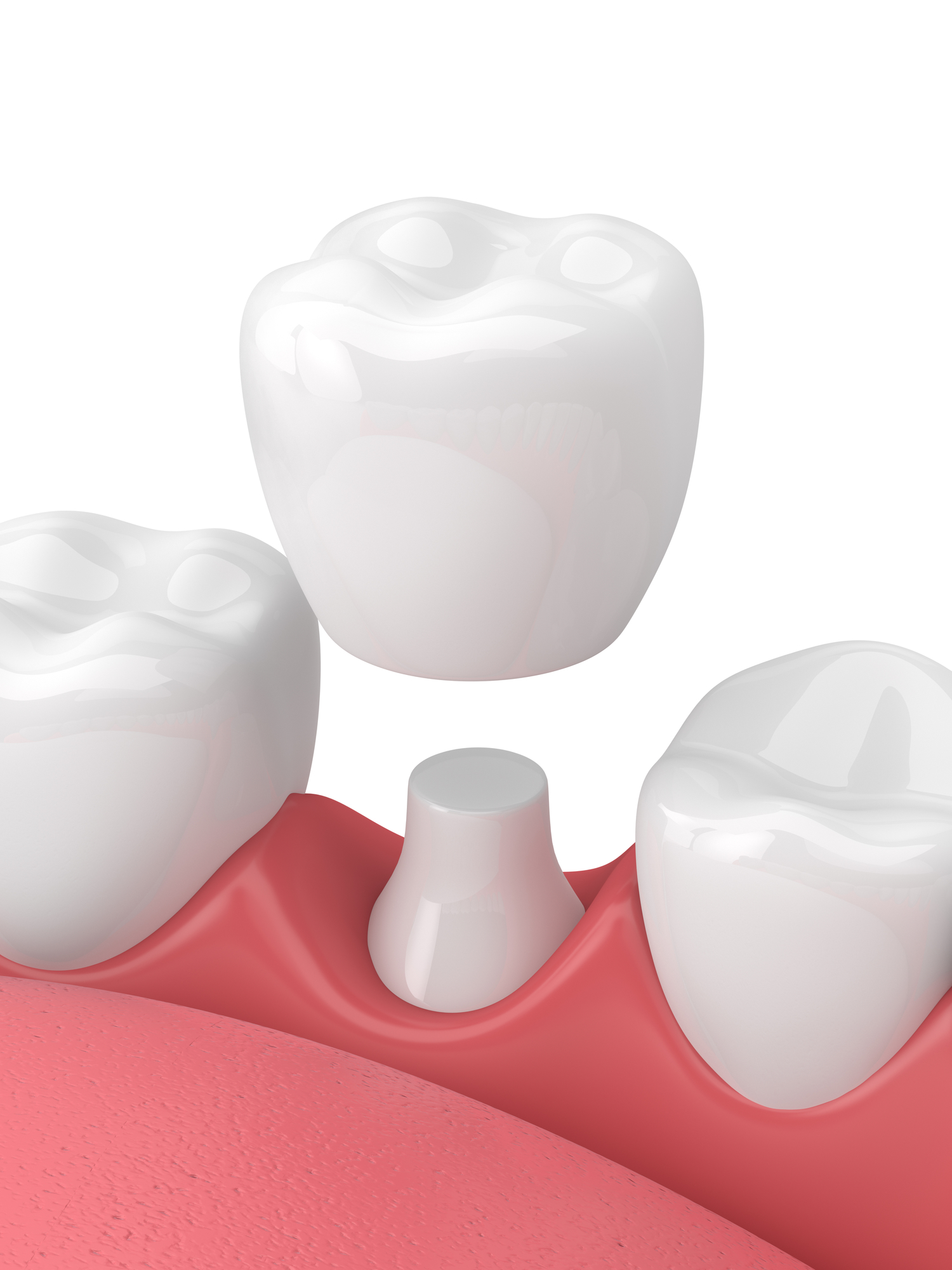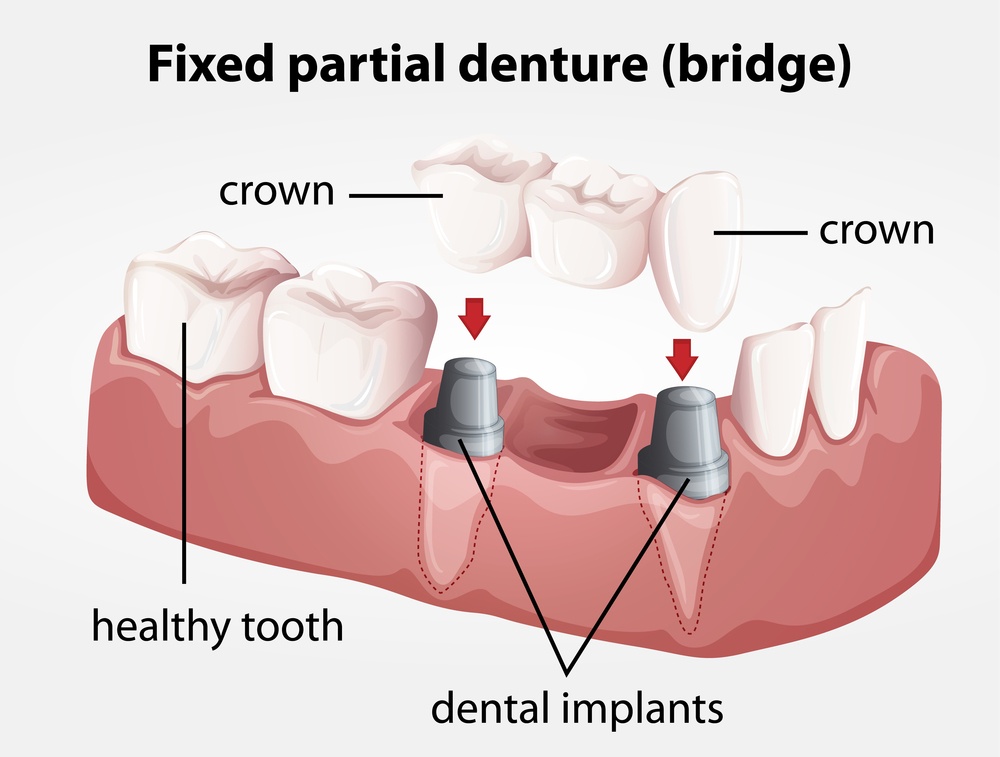Crowns and Bridges
Crowns

A dental crown is an individually handcrafted tooth shaped cover with the purpose to protect any weak teeth and re-create your natural smile. A bridge is simply 2 or more crowns joined together. We generally use bridges to replace a missing tooth in your mouth. Read more at the bottom of this page.
Crowns are used when large amounts of the tooth is lost due to injury or decay and tooth is very compromised, especially after root canal treatment. They are stronger than regular fillings and thus allow you to keep your tooth for longer.
Crowns are usually made of either ceramic or metal. Metal crowns can be used in your back teeth so that when you smile the metal is not visible. Ceramic crowns are used for your front teeth so that it not only protects your tooth, but at the same time white in colour and mimics the colour of your other natural teeth.
Crowns can be used to:
Get ideal contact with the teeth next door or opposite tooth, for teeth that are getting food trapped between them
What is the difference between a filling and a crown?
Crowns have been proven to last much longer than fillings. Why? Several reasons
A white filling does not reinforce the tooth. It relies on bonding to what tooth structure is left, and simply replaces what was lost. When you bite down on the filling, it puts stress on the tooth structure that is holding it in place. Fillings work really well if there is a lot of tooth structure left, but once there is more filling than there is tooth, this is when we are at risk. Either the filling continues to fail, or there is too much stress on the tooth left and it falls apart.
A crown wraps around the entire tooth and fits exactly. This means that when you bite down on a crown, it takes that force and distributes it across the whole tooth. It protects the tooth structure that remains.
The other good thing about crowns is they reduce the ability for decay to get to the tooth. It is very difficult to get ideal contact between the teeth with fillings, they are rougher (meaning bacteria stick to them more) and they have a lot of margin (where the filling meets the tooth) where bacteria sit and start to break down the tooth again. As crowns are designed exactly for your tooth, we can achieve much better contacts between the teeth, meaning its easier to keep clean. They are also polished in the lab rather than in your mouth and metals and porcelains polish to a much smoother surface, meaning its harder for bacteria to stick to. The custom-fit means we can achieve a very small margin between the tooth and the crown, so the only way that bacteria can get to the crown is by getting under the crown and eating away the tooth that is holding the crown.
When we cement or bond your crown in, we will show you how to keep this margin clean to give your crown the very best chance of lasting for the long term. What happens during the appointments?
A crown is made to fit your tooth exactly, thus they require two appointments. In the first appointment, a local anaesthetic is given to numb that particular tooth. The tooth is cleaned so that it is free from bacteria. The tooth is prepared such a way that the crown can seat firmly on the tooth. An impression (mould) is taken of the tooth and sent to our lab technician who will make the crown so that it fits your tooth precisely. A temporary crown will be made to cover your tooth in the meantime whilst the inlay/onlay is made. During this time there may be some sensitivity on the tooth, and we ask you to avoid chewing on the tooth.
The second appointment will be two to three weeks later. A local anaesthetic may be given to numb the tooth. The temporary crown is removed and the tooth is cleaned. After we have made sure the crown fits your tooth exactly it will be cemented in place.
Bridges

Bridges are 2 or more crowns joined together. They allow us to use an existing tooth (abutment tooth) to support a fake tooth (pontic) to replace a gap.
They are just one of the ways that you can replace a missing tooth. Please read our page on replacing a missing tooth [hyperlink]. As there are so many factors that come into play when replacing a tooth, it is best to come in so we can assess your particular situation
There are several types of bridges
- 1Conventional bridge
- 2Fibre-reinforced direct bonded bridge
- 3Bonded indirect bridge
When might we recommend a bridge?
What are the disadvantages of a bridge (conventional)?
It relies on your existing teeth and joins them together. Therefore if anything happen to the teeth that are supporting your bridge, the entire bridge fails. You don't just lose that one tooth.
We crown the teeth either side of your space. Thus, we have to reduce them down to give ourselves space for the crown. This is an advantage if these teeth have big fillings, as the crowns will strengthen them. However if those teeth do not have fillings, we would have to take away good tooth structure, which is very destructive.
As the bridge is several teeth joined together, they are a little bit harder to clean. You have to use a special floss to get under the bridge to clean it.
If the bone below the fake tooth (where your gap is) shrinks down, you may start to notice a gap between your bridge and the gum
Inlays and Onlays
Inlays and Onlays are used when fillings are not a suitable solution. This is typically the case when a large amount of the tooth is lost due to injury or decay and tooth is very compromised. They are stronger than regular fillings and thus allow you to keep your tooth for longer. The other good thing is that they are made outside the mouth, and it is much easier to get a good contact with the teeth next door and the best contact with the opposite tooth.
Inlays fit into the tooth whereas onlays sit on top of the remaining tooth structure. Inlays and Onlays are generally made of ceramic, thus they are strong, but at the same time white in colour and mimics the colour of your natural teeth.
Inlays and onlays are made to fit your tooth exactly, thus they require two appointments. In the first appointment, a local anaesthetic is given to numb that particular tooth. The tooth is cleaned so that it is free from bacteria. An impression (mould) is taken of the tooth and sent to our lab technician who will make the inlay/onlay so that it fits your tooth precisely. A temporary will be made to cover your tooth in the meantime whilst the inlay/onlay is made. During this time there may be some sensitivity on the tooth, and we ask you to avoid chewing on the tooth.
The second appointment will be two to three weeks later. A local anaesthetic may be given to numb the tooth. The temporary is removed and the tooth is cleaned. After we have made sure the inlay/onlay fits your tooth exactly it will be cemented in place
